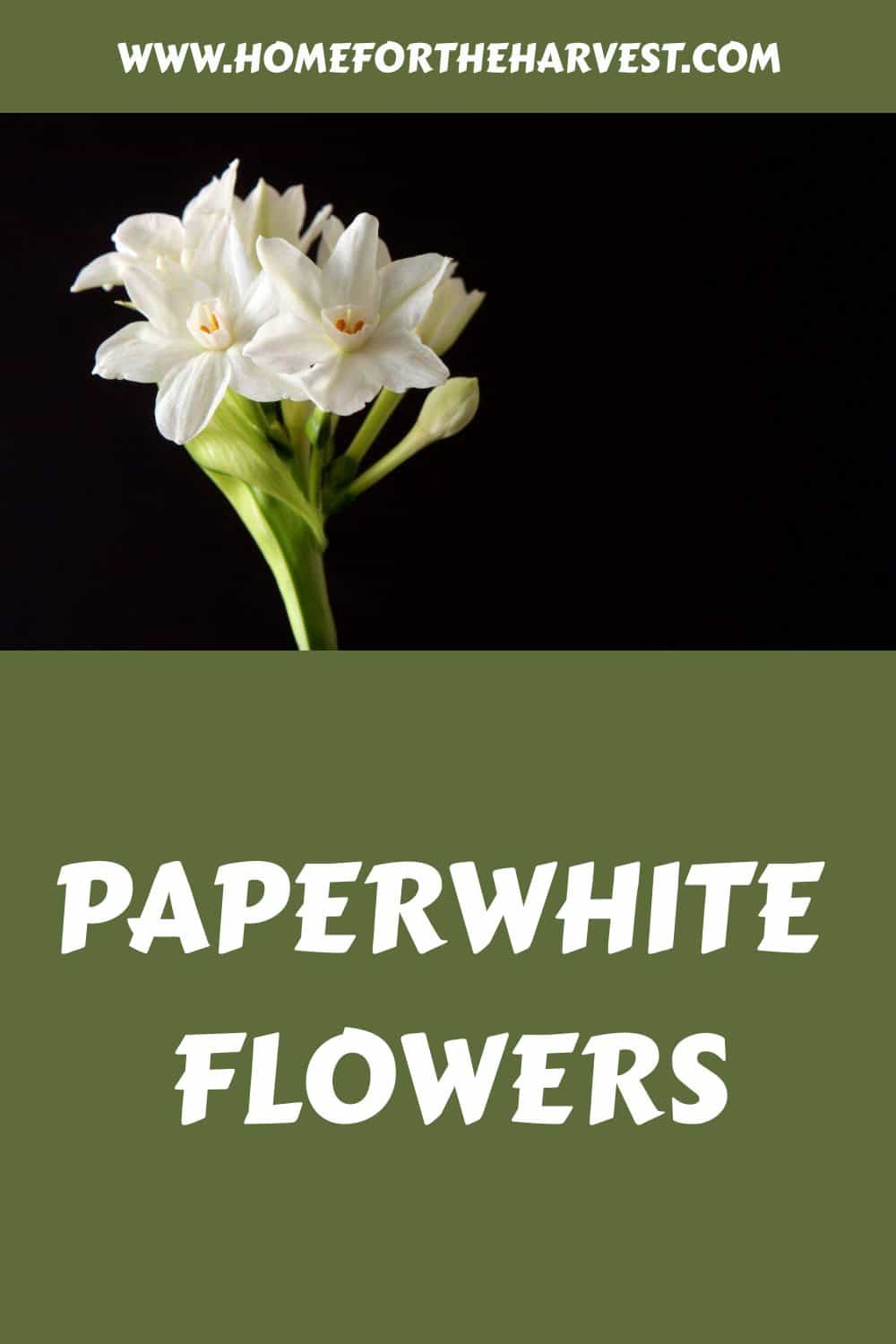The Paperwhite flower (Narcissus papyraceus) is a Mediterranean daffodil with dainty white flowers. These flowering bulbs are most commonly planted indoors during the cooler months of the year. Paperwhite bulbs are low-maintenance, needing only a bit of water to sprout up and flower. Paperwhites are winter-hardy when grown outdoors in warm regions from Zones 8-11.
Paperwhite flower basics
Paperwhite flowers are perennial bulbous flowering plants native to the Mediterranean. The botanical name for Paperwhites is Narcissus papyraceus, which translates to the paper-like daffodil. Most varieties have pure white flower petals, a white corona, and a small amount of yellow showing in the center stamens of the flower. The Paperwhite is a type of Tazetta Daffodil.
Paperwhite bulbs are about 2″ wide. Each bulb sends up a flower stem that grows a cluster of about seven flowers. While most bulbs sold send up only 1-2 stems, particularly large paperwhite bulbs may grow up to 3-4 stems each. Each flower is just less than an inch wide (about 2 cm). Most Paperwhites have a strong floral fragrance, but there are also cultivars with little to no scent.
Paperwhite plants form flower buds inside the bulb in the summer after blooming. The flower buds stay inside the bulb during the dormant season before rising up on the stem the following year. Unlike other daffodils, Paperwhite flower bulbs do not require a chilling period to complete their annual growth cycle. Forcing Paperwhites is a popular indoor gardening project in fall and winter.
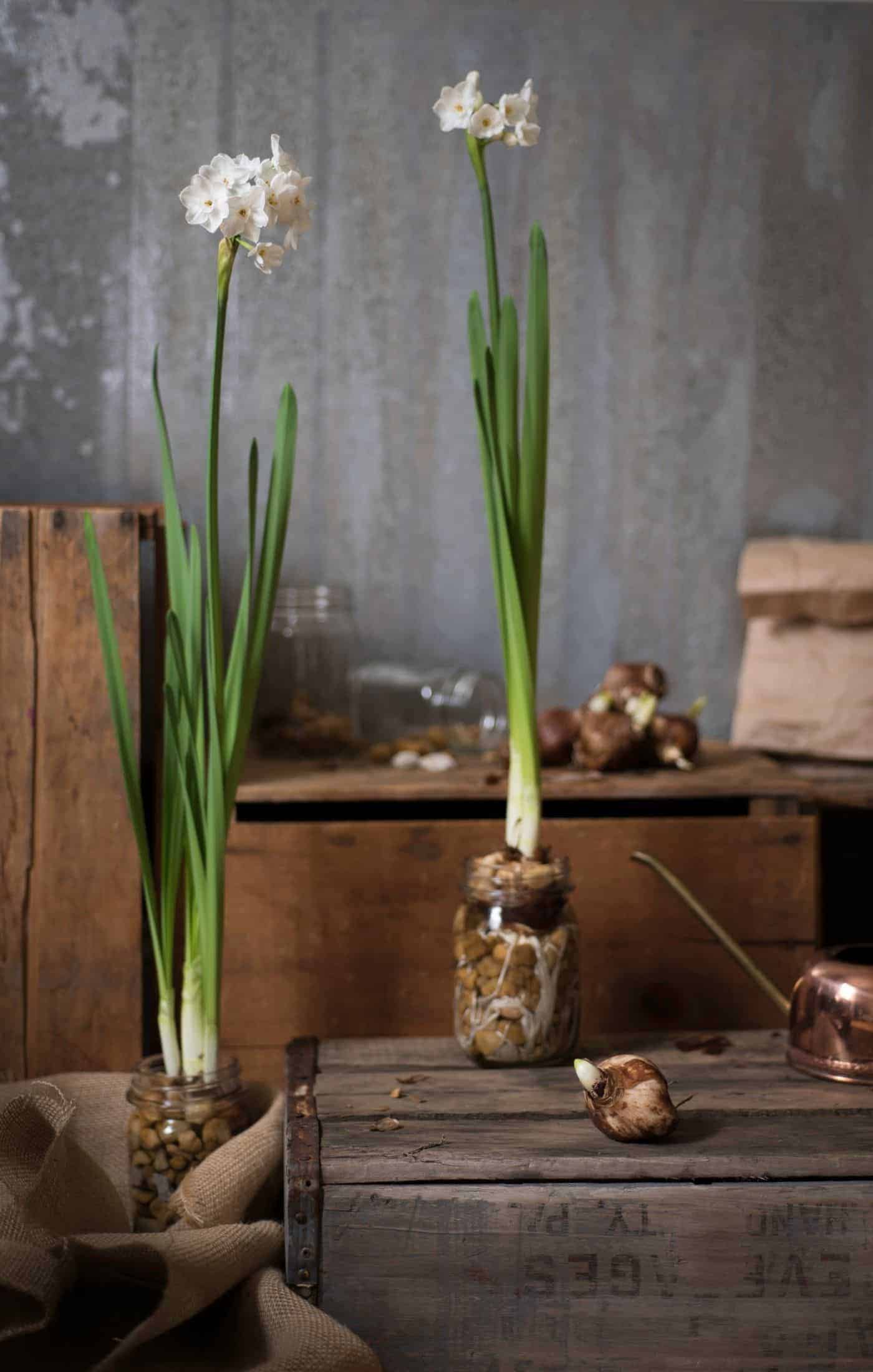
Paperwhite bulbs can be planted from October-February. The flowers tend to bloom from November to March, depending on when they have been planted. Many Paperwhite flower varieties have fragrant blooms, but there are some cultivars that are quite mild, including ‘Ariel’ and ‘Israel.’
The time between planting and blooming depends upon how long the bulb has been in dormant storage. While the bulbs appear to be doing nothing in storage, they are slowly developing the basic structures of the above-ground foliage and flowers. The longer bulbs are stored, the more quickly they bloom after planting. Paperwhite bulbs planted in late October may take 6-8 weeks to bloom, while those planted around Thanksgiving may only take four weeks. Paperwhite bulbs planted in January can take as little as 2-3 weeks to bloom.
Paperwhite flowers can be planted outdoors in Zones 8-11. Winter temperatures in these zones are not typically cold enough to harm the bulbs while they lie in winter dormancy (although they may not survive an overly cold winter, especially in Zones 8-9).
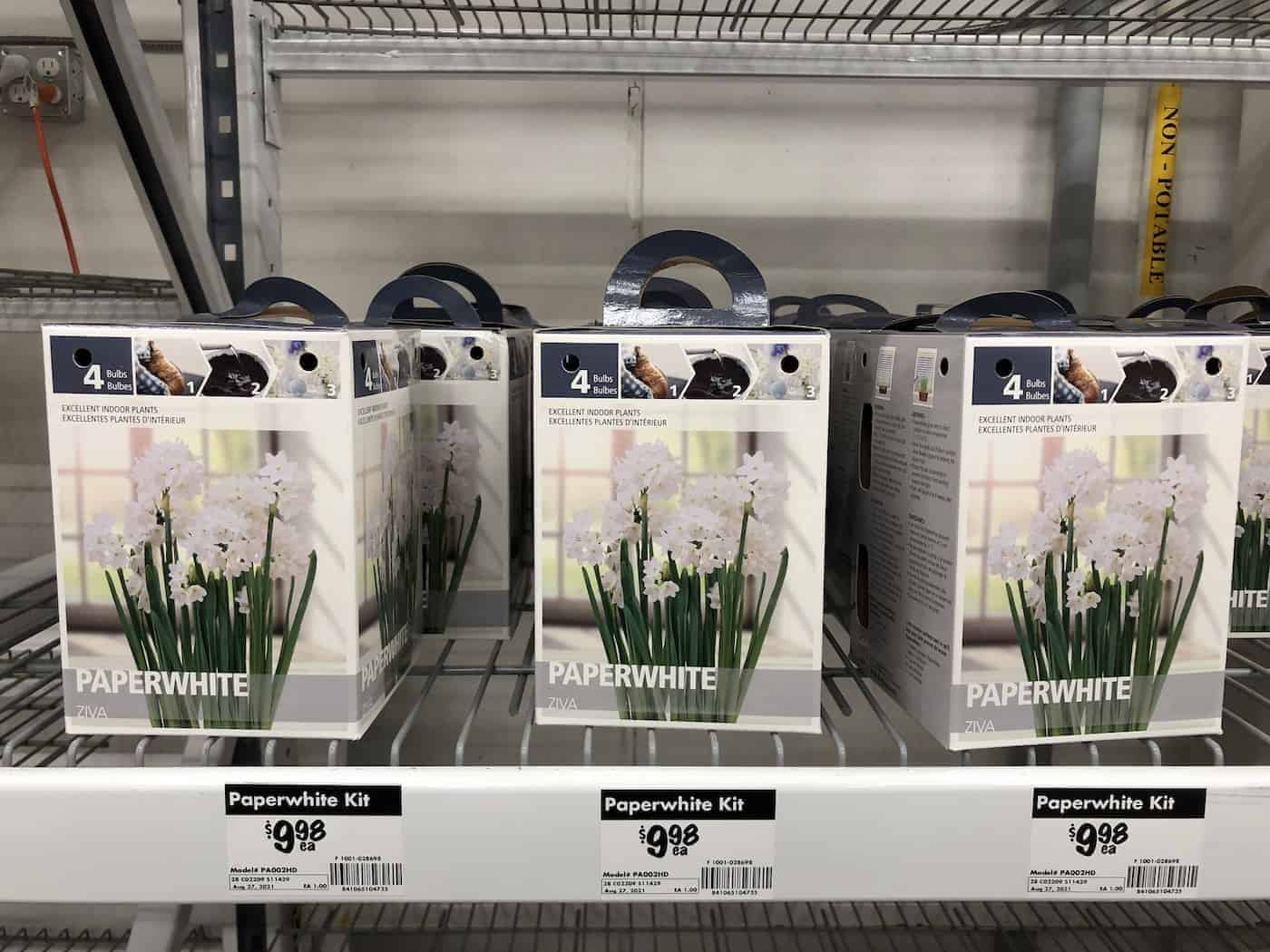
Buying Paperwhite flowers
Paperwhite flowers can be purchased either as bare flower bulbs (or kits containing bulbs) or already potted up in small planters. Bulbs are readily available from online plant nurseries and in garden centers, while potted plants are more common in supermarkets and grocers. Most Paperwhites sold today are the ‘Ziva’ cultivar, the most popular variety.
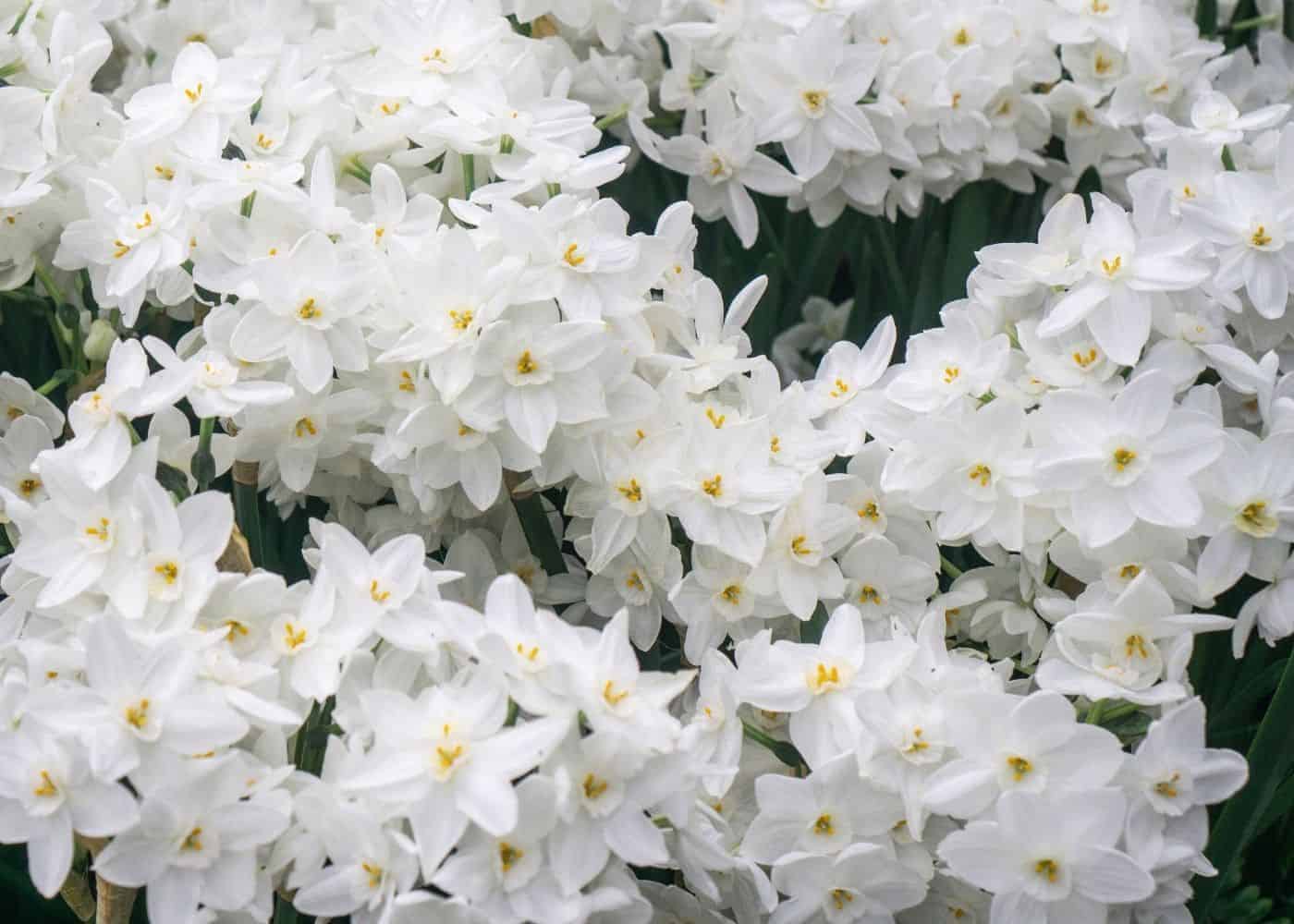
Planting Paperwhite flower bulbs
Paperwhite flower bulbs can be planted in water, pebbles, or in a potting mix. These tender bulbs don’t need to be chilled before planting. It is, however, important to open up the package as soon as you receive it to give the bulbs some air circulation.
Paperwhite bulbs can be planted right away or stored in a cool dark spot indoors at room temperature. If you purchase a large pack of bulbs, consider planting them in 2-week intervals for a continuous display of flowers. To have Paperwhites blooming at Christmas, most gardeners plant the bulbs at Thanksgiving.
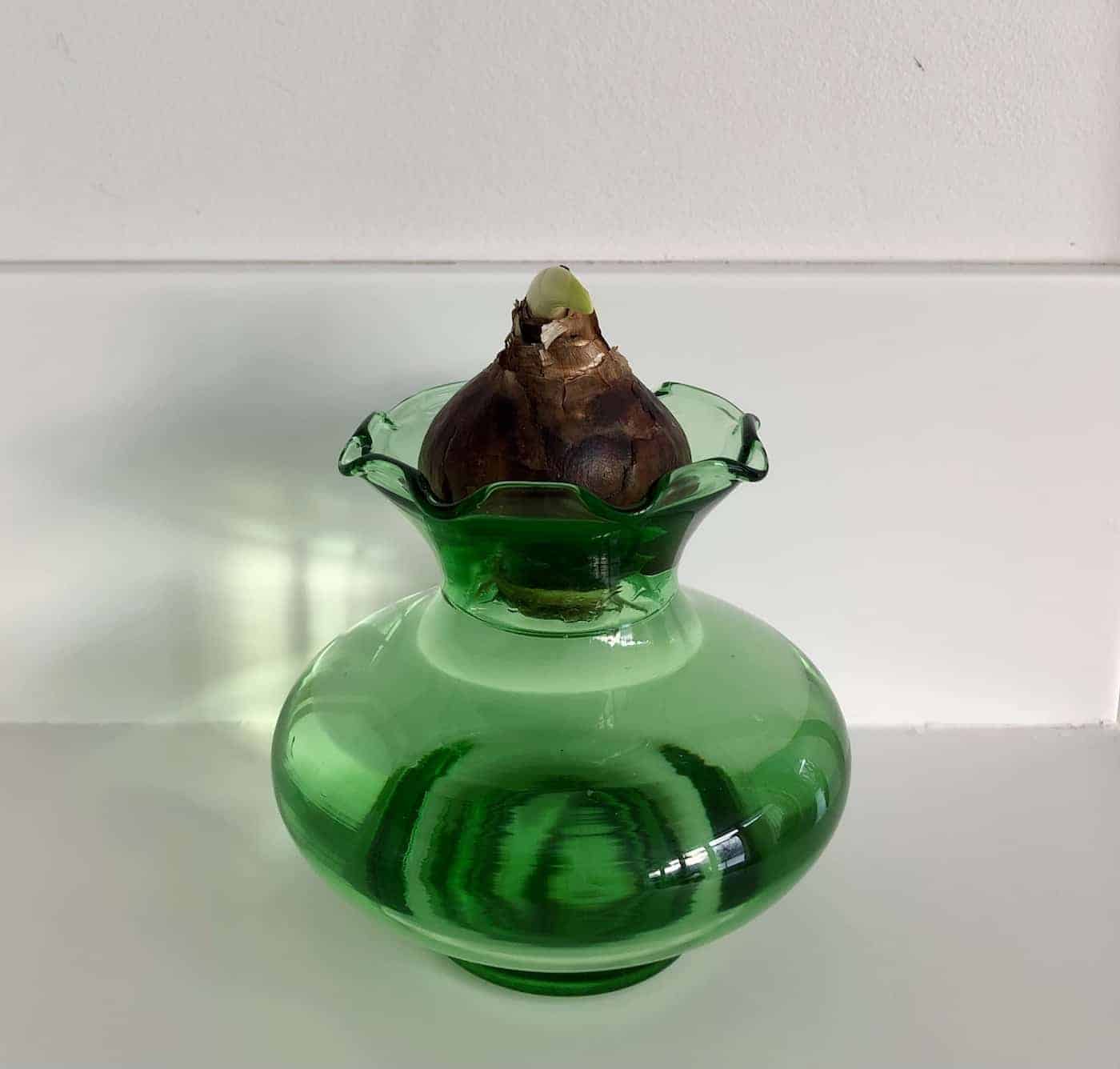
Planting Paperwhites in water
Paperwhite bulbs can be grown in water alone for an elegant wintertime display. These water-grown bulbs are typically quite beautiful when planted alone or in a small group of 3-4 bulbs. It is also nice to forgo the mess of potting soil.
The most important aspect of planting Paperwhites in water is to choose an adequate bulb vase. These vases have an hourglass shape that holds the bulb above the water’s surface. This shape allows the roots to access water without having the bulb itself sit in water (which often causes bulb rot).
Start by soaking the paperwhite bulb in clean water for 2-4 hours. Drain and rinse off the bulb before setting it on a cloth to dry out a bit. Fill the glass vase with clean, fresh water so that the water level is just below the narrowest point in the middle of the vase. Place the bulb into the bulb vase. The bottom of the bulb should just touch the surface of the water. Change the water in the vase every ~3 days.
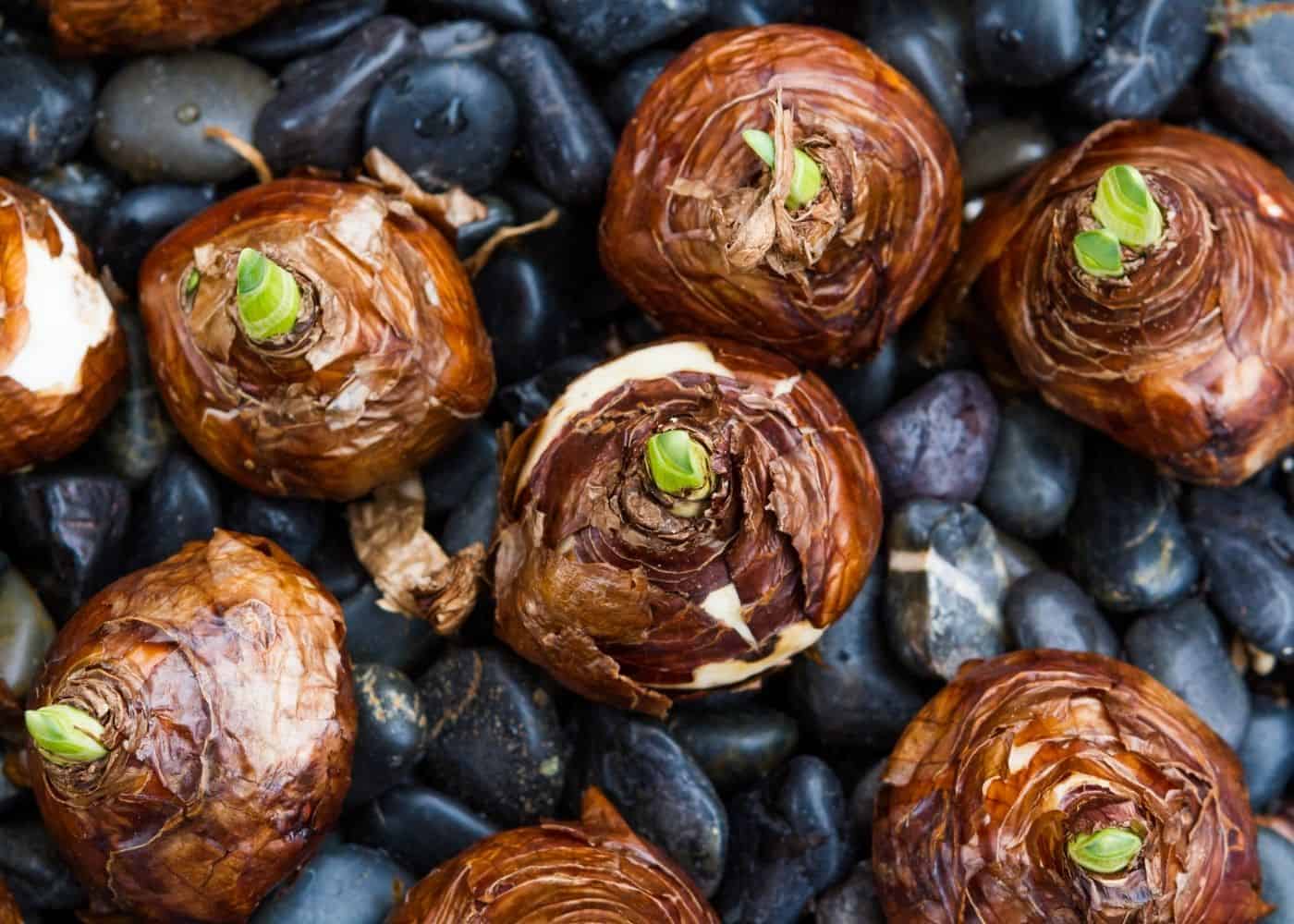
Planting Paperwhites in pebbles
Paperwhite flowers are often planted in pebbles. For this method, you’ll need a growing container that’s about 4″ deep. Shallow glass vases work well, as do tray-like bowls. Deeper containers can also work, especially if you’d like to add lots of pebbles or would like the bulbs to grow up inside the contained space of a tall glass vase. Whatever the depth, the container should not have drainage holes, as there will be standing water inside the vase.
Add a layer of pebbles to the bottom of the vase, about 1″-2″ deep (or deeper in tall vases). You can use pea gravel, decorative rocks, glass marbles, or even glass beads.
Place the Paperwhite bulbs on top of the pebble bed with the pointed end facing upwards. Bulbs planted in this manner can be placed very closely together (but not touching if possible). A good rule of thumb is that 4 Paperwhite bulbs tend to fit nicely in a 6″ wide pot. If the bulbs are wobbly, add more pebbles around the sides to hold them upright. Avoid putting pebbles on top of the bulbs (leave the tops exposed).
Add clean, fresh water to the vase so the water just touches the bottom of the Paperwhite bulbs. Water should not be more than 1/3 of the way up the bulb (at most). Putting too much water in the vase often leads to bulb rot.
Check the bulbs each day to watch for sprouts, watch for roots, and observe water levels. Add more water if required touch the very bottom of the bulbs. Drain and change the water 1-2 times per week to keep it fresh. As roots develop, decrease the water level so the bulb does not touch the water. Only the roots should hang down into the water once they grow downwards.
When roots and green sprouts start to become visible, move the planted Paperwhites to a bright area. The plants can stay in this spot until they are done flowering or can be moved out of direct sunlight once they start to bloom to help the flowers last a bit longer on the plant.
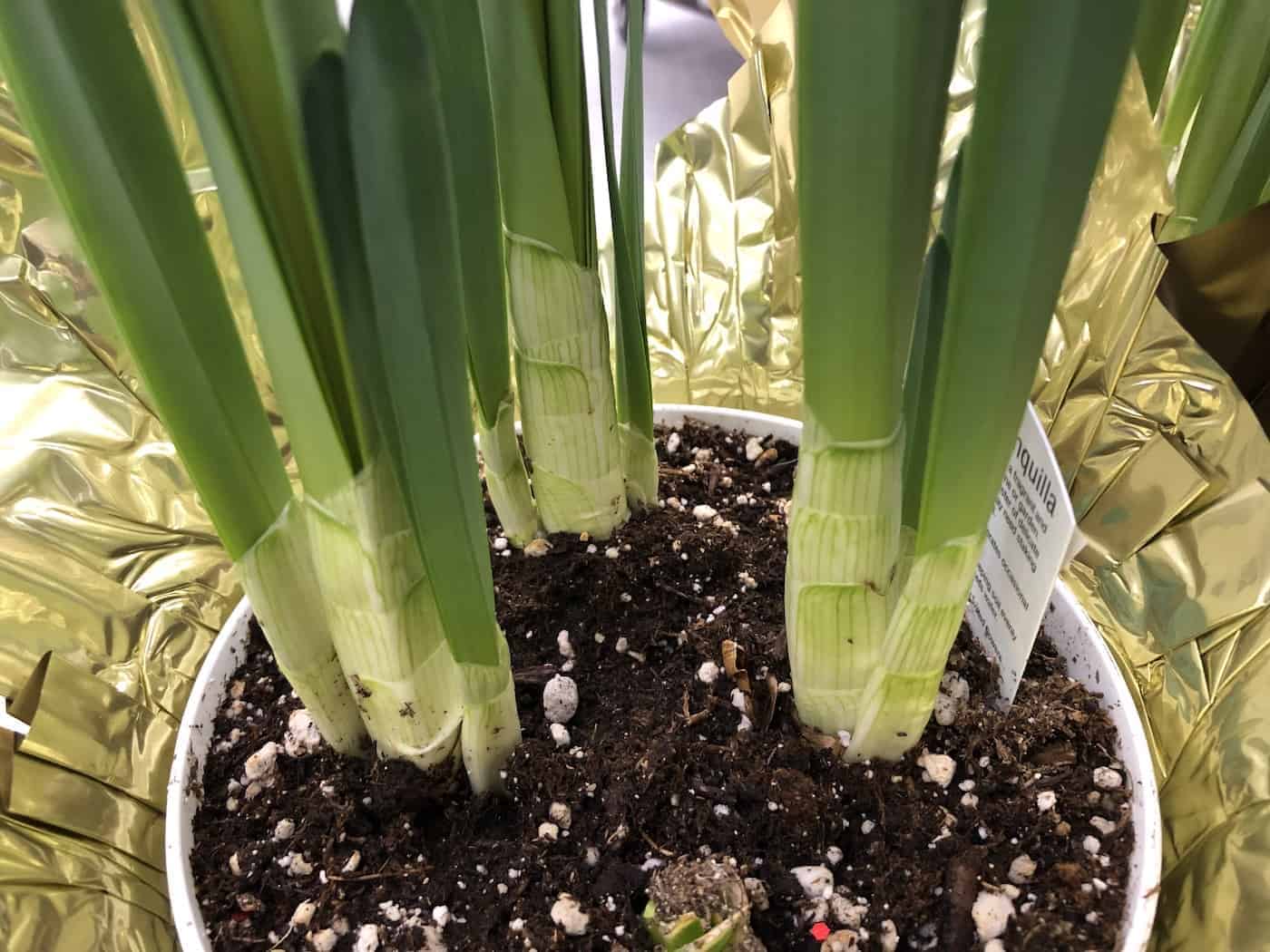
Planting Paperwhites in potting soil
Paperwhite flowers are very commonly planted in potting soil. You’ll need a planter with a drainage hole to allow excess water to escape. A 6″ wide container is sized well for planting 4 Paperwhite bulbs. The best potting mixes for paperwhites are lightweight soil-free blends.
Add a bit of water to the potting mix to dampen it. This is easiest to do in a mixing bowl or tub. The potting soil should be damp but not muddy. Fill the planter with damp potting mix until the planter is about 3/4 full.
Gently place each bulb on top of the potting mix with the pointy end up. Paperwhite bulbs planted in containers can be placed quite closely (but try to keep them from actually touching each other too much). Sprinkle a bit of potting mix over the bulbs and gently compress down the sides. The potting mix only needs to go about halfway up the sides of the bulbs. Leave the tips of the Paperwhite bulbs exposed to the open air.
Water the planted bulbs thoroughly. Check to ensure water drains easily from the bottom of the planter. Paperwhite bulbs are prone to rot if their planting containers do not drain water easily. Also, check the soil level around the bulbs. Add a bit more soil around the sides of the bulbs if the soil level has decreased significantly (but leave the bulb tips uncovered). Lastly, if desired, cover the soil surface with an ornamental topper like decorative stones or dry sheet moss.
Leave the planted bulbs in a warm spot to sprout. Move them to a sunny windowsill or under a plant light once the sprouts appear. Flowering Paperwhites can be kept out of direct sunlight to promote longer-lived blooms.
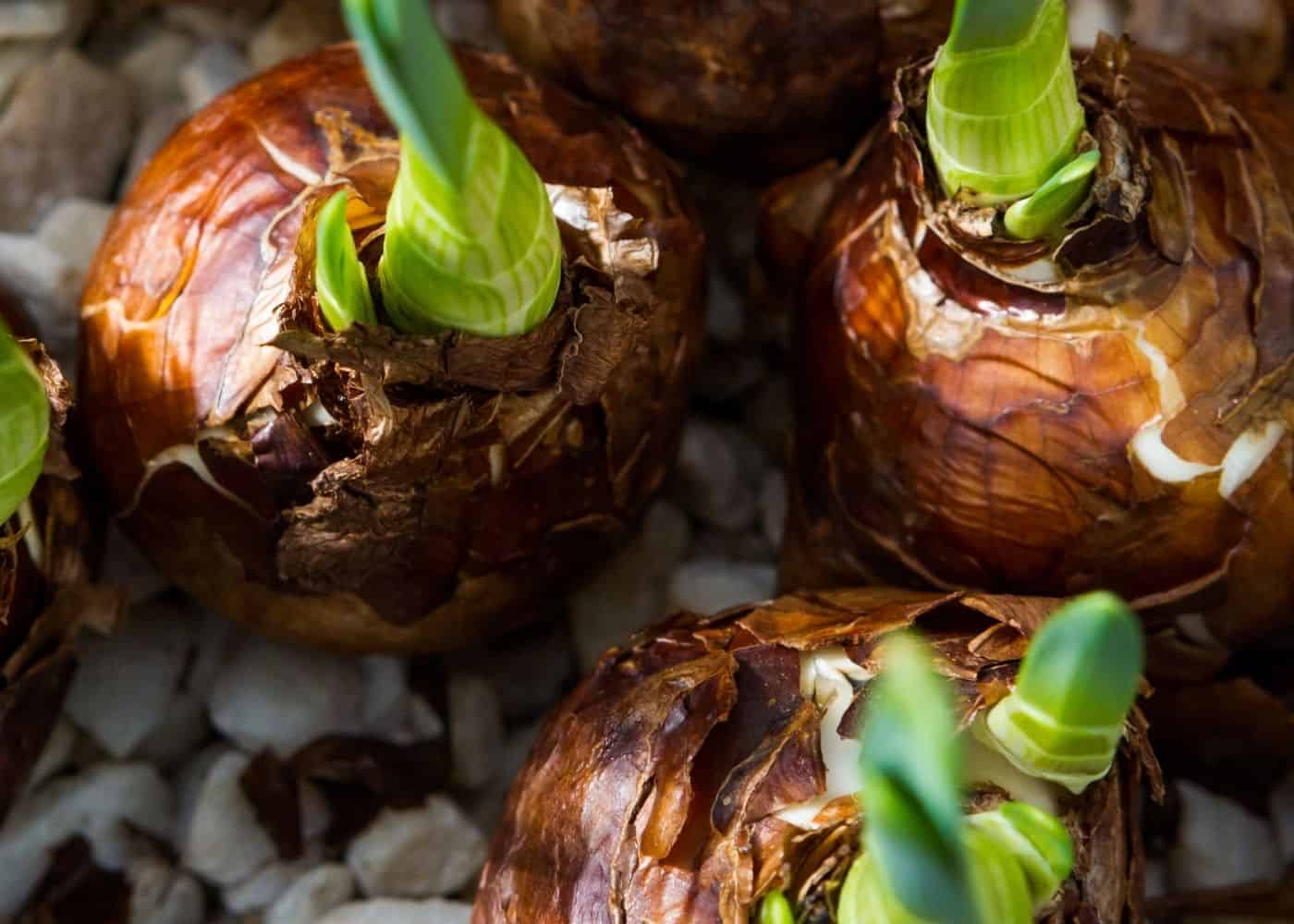
Caring for Paperwhite flowers
Newly planted paperwhite bulbs are best kept in a cool spot indoors out of direct sunlight. The ideal temperature for sprouting bulbs is in the range of 50°-60°F (10°-16°C), but these bulbs will sprout just fine at room temperature.
Keeping water levels balanced is the most important care aspect at this point of growth. Paperwhites grown in water or pebbles should barely be touching the water’s surface when first planted. As soon as downward-growing roots are visible, decrease the water level so that the bulb is not sitting in the water. Only the roots should extend down into the water reservoir. Newly planted Paperwhites grown in a potting mix can be watered whenever the top inch of the potting mix is dry. Actively growing Paperwhites consume quite a bit of moisture and should be checked daily to ensure they are getting enough water.
Check the bulbs frequently for signs of growth, including root development and the start of green shoots. This process usually takes a couple of weeks. Once growing roots are visible, move the Paperwhites to a bright, warm location, such as a sunny spot on a windowsill or under a plant light. Direct sunlight (or artificial bright light) is preferable at this point to promote photosynthesis. Once blossoms appear, the plant can be moved out of direct sunlight to help the flowers last longer.
One of the most common plant care complaints with Paperwhite flowers is that the leaves tend to flop over while the plants are in bloom. If your Paperwhites are falling over, use sticks to make tiny plant stakes or tie a wide ribbon around all the stems and foliage. If using the same brand of bulbs in future years, consider growing Paperwhites inside a tall glass vase or stunting their growth with an alcohol solution (see below).
Pickling Paperwhites To Stunt Height
“Pickling” paperwhites with a solution of diluted alcohol is a common method of shortening the height of Paperwhite plants. The shorter stems are easier to display and less likely to flop over. Pickling is generally done with paperwhites grown in water or planted in pebbles (or another soil-less media).
The idea is to water sprouting bulbs with a ~5% alcohol solution for about a week before the plants get too tall. This usually reduces the mature height by about 1/3 of the expected height (source: Cornell University). Instead of 16″-18″ tall Paperwhites, you get plants that are only about 12″ tall.
Start the bulbs off with plain fresh water. About a week after planting, look for signs of growth (roots and stems). Once the green stem is 1″-2″ tall, empty out the plain water and replace it with a dilute alcohol solution.
You can make the dilute alcohol solution with rubbing alcohol or clear liquor spirits like vodka or gin. The solution should be approximately 5% alcohol. If using a 40%-alcohol distilled spirit, use 1 part of the spirit with 7 parts water. So to make 2 cups of solution, mix 1 ¾ cups of water with ¼ cup of 40% liquor. Do not use sugar-containing alcohols like beer or wine, and do not exceed 10% alcohol in the solution. Paperwhite plants can be watered with the dilute alcohol solution until they start to flower.



